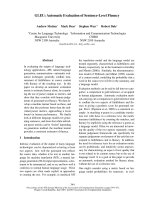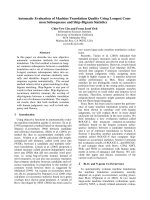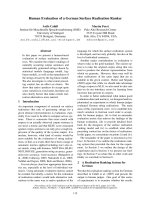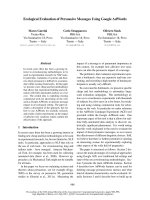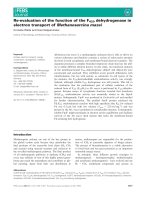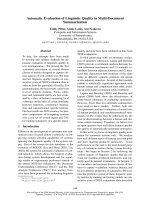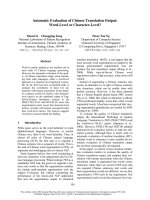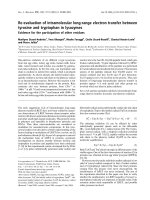báo cáo khoa học: " Preclinical evaluation of KIT/PDGFRA and mTOR inhibitors in gastrointestinal stromal tumors using small animal FDG PET" ppsx
Bạn đang xem bản rút gọn của tài liệu. Xem và tải ngay bản đầy đủ của tài liệu tại đây (429.64 KB, 7 trang )
RESEA R C H Open Access
Preclinical evaluation of KIT/PDGFRA and mTOR
inhibitors in gastrointestinal stromal tumors using
small animal FDG PET
Maria Abbondanza Pantaleo
1,6*
, Giordano Nicoletti
2
, Cristina Nanni
3
, Chiara Gnocchi
4
, Lorena Landuzzi
2
,
Carmelo Quarta
3
, Stefano Boschi
5
, Margherita Nannini
1
, Monica Di Battista
1
, Paolo Castellucci
3
, Stefano Fanti
3
,
Pier Luigi Lollini
1
, Elena Bellan
7
, Mauro Castelli
8
, Domenico Rubello
9*
, Guido Biasco
1,6
Abstract
Background: Primary and secondary drug resistance to imatinib and sunitinib in patients with gastrointestinal
stromal tumors (GISTs) has led to a pressing need for new therapeutic strategies such as drug combina tions. Most
GISTs are caused by mutations in the KIT receptor, leading to upregulated KIT tyrosine kinase activity. Imatinib and
nilotinib directly inhibit the kinase activity of KIT, while RAD001 (everolimus) inhibits mTOR. We report a preclinical
study on drug combinations in a xenograft model of GIST in which effects on tumo r dimensions and metabolic
activity were assessed by small animal PET imaging.
Methods: Rag2-/-; gcommon -/- male mice were injected s.c. into the right leg with GIST 882. The animals were
randomized into 6 groups of 6 animals each for different treatment regimens: No therapy (control), imatinib (150
mg/kg b.i.d.) by oral gavage for 6 days, then once/day for another 7 days, everolimus (10 mg/kg/d.) by oral
gavage, everolimus (10 mg/kg/d.) + imatinib (150 mg/kg b.i.d.) by oral gavage for 6 days, then once/day for
another 7 days, nilotinib (75 mg/kg/d.) by oral gavage, nilotinib (75 mg/kg/d.) + imatinib (150 mg/kg b.i.d) by oral
gavage for 6 days, then once/day for another 7 days. Tumor growth control was evaluated by measuring tumor
volume (cm
3
). Small animal PET (GE Explore tomography) was used to evaluate tumor metabolism and performed
in one animal per group at base-line then after 4 and 13 days of treatment.
Results: After a median latency time of 31 days, tumors grew in all animals (volume 0,06-0,15 cm
3
) and the
treatments began at day 38 after cell injection. Tumor volume control (cm3) after 13 days of treatment was > 0.5
for imatinib alone and nilotinib alone, and < 0.5 for the 2 combinations of drugs and for everolimus alone. The
baseline FDG uptake was positive in all animals. FDG/SUV/TBR was strongly reduced over time by everolimus both
as a single agent and in combination with imatinib respectively: 3.1 vs. 2.3 vs. 1.9 and 2.5 vs 2.3 vs 0.
Conclusions: As single agents, all drugs showed an anti-tumor effect in GIST xenografts but everolimus was
superior. The everolimus plus imatinib combination appeared to be the most active regimen both in terms of
inhibiting tumor growth and tumor metabolism. The integration of everolimus in GIST treatment merits further
investigation.
* Correspondence: ;
1
Department of Hematology and Oncology Sciences “L.A.Seragnoli”, Sant’
Orsola-Malpighi Hospital, University of Bologna, Bologna, Italy
9
Department of Nuclear Medicine, Santa Maria della Misericordia Hospital,
Rovigo, Italy
Full list of author information is available at the end of the article
Pantaleo et al. Journal of Experimental & Clinical Cancer Research 2010, 29:173
/>© 2010 Pantaleo et al; licensee BioMed Central Ltd. This is an Open Access articl e distribute d under the terms of the Creative
Commons Attribution License (http://cr eativecommon s.org/licenses/by/2.0), whic h permits unrestricted use, distribution, and
reproduction in any medium, provided the original work is properly cited.
Introduction
Gastrointestinal Stromal Tumors (GISTs) are a rare
malignancy originating from Cajal’s cells of the gastroin-
testinal tract. Most GISTs are caused by mutations in
the KIT and PDGFRA receptors, leading to upregulated
tyrosine kinase activity [1,2]. Tyrosine kinase inhibitors
(TKIs), imatinib and sunitinib, are the standard treat-
ment for patients with advanced or unresectable GIST
[3,4]. However, the occurrence of primary and second-
ary drug r esistance to TKIs has led to a pressing need
to develop new drugs or new strategies such as drug
combinations [5-7]. Nilotinib is a second-generation
multitarget TKI that directly inhibits the kinase activity
of KIT and PDGFRA receptors and also BCR-ABL,
PDGFRA and KIT [8]. Nilotinib has been shown to be
active in a small series of patients pre-treated with
imatinib and sunitinib [9,10]. RAD001 (everolimus)
inhibits the mammalian target of rapamycin (mTOR)
which is involved in various intracellular signaling
pathways and represents a therapeutic target for treat-
ments of solid tumors [11,12]. mTOR may be activated
as an alternate oncogenic signaling mechanism in TKI
resistance and mTOR inhibitors have yielded interest-
ing results in GIST even if they emerged from small
series of patients [13-18]. The rationale of the TKIs
and RAD001 combination derives from an in vitro
demonstration on resistant GIST cell lines where ever-
olimus associated with imatinib had a synergic antitu-
mor effect. The combination of TKIs and mTOR
inhibitors may be promising for a more complete inhi-
bition of the KIT/PDGRA signaling pathway and a bet-
ter tumor response.
As is well known from the clinical setting, the tumor
response still cannot be evaluated using the traditional
RECIST (Response Evaluation Criteria in Solid Tumors)
alone because mostly TKIs do not lead to lesion shrink-
age [19-21]. Therefore, the CHOI criteria have been stu-
died using both tumor size and density variations to
evaluate GIST lesions treated with imatinib [22]. As a
result, the preclinical development of new drugs or a
combination of drugs and molecular targets should be
planned with a modern approach based on tumor
dimensions and metabolic activity evaluation [23,24].
We recently developed a xenograft model of GIST mea-
suring tumor metabolism using small animal PET ima-
ging [23].
The aim of this work is to report a preclinical study
on the a ntitumor activity of drug combinations, TKIs
and m-TOR inhibitors, in a xenograft model of GIST in
which the drug effects were assessed by small animal
PET imaging evaluating both tumor growth control and
tumor glucose metabolism.
Materials and methods
Experimental model
Tumor xenografts were developed with the GIST882
cell line provided by Dr. Jonathan A. Fletcher, Harvard
Medical School, Boston, Massachusetts, USA.
All data on the GIST882 cell line, cytofluorometric
studies and KIT and PDGFRA mutational analysis of
GIST882 cells showing a mutation on KIT receptor
exon 13 (homozygous mutation - K642E) were
reported in our previous article [23]. Rag2
-/-
;gc
-/-
bree-
ders were kindly given by Drs. T. Nomura and M. Ito
of the Central Institute for Experimental Animals [25];
mice were then bred in our animal facilities under
sterile conditions. The experiment was authorized by
the institutional review board of the University of
Bologna and done according to Italian and European
guidelines.
Tumor xenografts were induced into Rag2
-/-
;gc
-/-
male
mice by subcutaneous (s.c.) injection of 10
7
viable
GIST882 cells in 0.2 ml phosphate-buffered sa line (PBS)
into the right leg. Tumor incidence and growth were
evaluated three times a week. Neoplastic masses were
measur ed with calipers; tumor volume was calculated as
π.[√(a. b)]
3
/6, where a = maximal tumor diameter and
b = tumor diameter perpendicular to a.
Two months after cell injection mice were sacrificed
by CO
2
inhalation and necropsied.
Treatments protocols
Animals were randomized into 6 groups of 6 animals
each one for different treatment regimens which were
given for 13 days:
* No therapy (control)
* Imatinib (150 mg/kg b.i.d.) by oral gavage for 6 days,
then once/day for another 7 days
* Everolimus (10 mg/kg/d.) by oral gavage
* Everolimus (10 mg/kg/d.) + imatini b (150 mg/kg b.i.
d.) by oral gavage for 6 days, then once/day for another
7 days
* Nilotinib (75 mg/kg/d.) by oral gavage
* Nilotinib (75 mg/kg/d.) + imatinib (150 mg/kg b.i.d)
by oral gavage for 6 days, then once/day for another 7
days
Imaging studies
Imaging studies were perfo rmed using a small animal
PET tomograph (GE, eXplore Vista DR) using fluoro-
deoxyglucose (FDG) for glucose metabolism. Animals
had PET scans after gas anaesthesia (sevofluorane 3-5%
and oxygen 1 l/min). FDG was injected into a tail vein.
FDG uptake was evaluated by standard uptake value
(SUV)/tumor background ratio (TBR). PET scans were
Pantaleo et al. Journal of Experimental & Clinical Cancer Research 2010, 29:173
/>Page 2 of 7
performed in one animal per group at base-line, and
after 4 and 13 days of treatment.
Results
After subcutaneous injection, tumors grew very slowly
and sometimes indolentl y (median latency time: 31
days) in all animals (volume 0,06-0,15 cm
3
). The treat-
ments began at day 38 after cell injection when all ani-
mals were tumor bearing. The mice were randomly
distributed in the 6 experimental groups to have the
same mean tumor volume in all experimental groups at
the start of treatment (Figure 1).
Before starting treatments, the in vivo tumor mass was
evaluated using small animal PET tomography in one
animal per group (37 days after cell injection). The
base-line FDG uptake was p ositive in all animals evalu-
ated with a mean SUV/TBR of 2.78 (range 3.12-2.23).
In the 6 groups, only three animals out of the 36 died
during the protocol, two in the imatinib group, and one
in everolimus + imatinib group. The efficacy of the
treatments was evaluated at first as effect on tumor
growth (dimensions measured by calipers). All treat-
ments were statistically different (at least p > 0.05) when
compared with the untreated group.
After 4 and 13 days of treatment, one representative
animal for each group was evaluated either with calipers
to measure tumor size (tumor v olume expressed in cm
3
at days 0 and 13 of treatments is shown in Figure 2)
and with PET tomography. At day 13, the mean tumor
volume of all animals per group was > 0.5 cm
3
for ima-
tinib alone and nilotinib alone, and < 0.5 cm
3
for the 2
combinations and for everolimus alone.
SUV/TBR at base line and after 4 and 13 days of
treatments was:
* Control: 3.08 base line; 2.19 (large necrosis) after 4
days; 1.19 (large necrosis) after 13 days
* Imatinib: 2.91; 2; 2.53
* Everolimus: 3.12; 2.3; 1.98 * Everolimus and imatinib:
2.59; 2.23; 0 (Figure 3)
* Nilotinib: 2.23; 1.42; 1.7 (Figure 4)
* Nilotinib + imatinib: 2.76; 3.28; 2.83;
The mouse in the imatinib group that had the first
baseline and the second PET scan after treatment died
during the protocol and the third PET scan was
Figure 1 Inhibition of tumor growth in Rag2-/-; gcommon -/-
male mice injected s.c. with GIST 882 by treatment p.o. with
untreated (-□-), imatinib (-◊-), everolimus ( ○ ), imatinib
+everolimus (-♦-), nilotinib ( ● ), nilotinib+imatinib (–▼-). The
dotted line marks the beginning of therapy. The tumor volumes are
expressed as mean ± E.S in cm
3
.
§
p > 0.01, *p < 0.05, Student’st
test compared with untreated group.
Figure 2 Tumor volume of the same animal per group also
examined by PET scan. The points indicate tumor volume,
measured with calipers, expressed in cm
3
at day 0 and at day 13 of
treatment. In imatinib group the tumor volumes refer to two
different animals. Rag2-/-; gcommon -/- male mice injected s.c. with
GIST 882 were treated p.o. with untreated (-□-), imatinib (-◊-),
everolimus ( ○ ), imatinib+everolimus (-♦-), nilotinib ( ● ), nilotinib
+imatinib (–▼-).
Figure 3 Small animal PET images for everolimus as a single
agent: pre-treatment lateral (A), coronal (B) and axial (C) SUV
TBR 3.12; post-treatment lateral (D), coronal (E) and axial (F)
SUV TBR 1.98.
Pantaleo et al. Journal of Experimental & Clinical Cancer Research 2010, 29:173
/>Page 3 of 7
performed in a second animal; this new animal was
comparable to the first one for tumor growth. Everoli-
mus strongly reduced FDG uptake both alone and in
combination with imatinib.
Discussion
Despite the dramatic results in disease control by TKIs
in GIST, patients may develop primary and secondary
drug resistance and this has led to a pressing need to
develop new drugs or new strategies such as drug
combinations.
We have developed a xenograft model of GIST suita-
ble for the preclinical study of new treatments evaluat-
ing both tumor size and function. This experiment used
the model to study t he antitumor activity of drug com-
binations, TKIs and m-TOR inhibit ors [23]. We st udied
the activity of ever olimus as a new single agent and two
combinations of agents, imatinib associated with niloti-
nib and imatinib associated with everolimus. Imatinib
and nilotinib as single agents were also evaluated for
comparison and a non-treated group of animals served
as a general control. As single agents all 3 drugs con-
trolled tumor growth. Everolimus alone was superior to
nilotinib and imatinib (tumor volume (cm
3
) after 13
days of treatment: 0.4 vs 0.6 vs 0 .6 respectively). Both
combined regimens were more effective than single
drugs (both 0.3 cm
3
vs > 0.4 cm
3
). Considering tumor
glu cose metabolism, the control group showed a reduc-
tion of FDG SUV value due to the progressive develop-
ment of necrosis due to a massive increase in tumor
size. The imatinib group cannot be co nsidered because
the mouse subjected to the first 2 PET scans died before
the third scan. All the other therapeutic r egimens
showed a reduction of FDG SUV value after treatment
administration, except the nilotinib and imat inib
combination where the FDG SUV value remained stable.
Attention should be paid to the everolimus and imatinib
combination where FDG uptake was progressively
reduced until there was no uptake after 13 days (SUV
2.59; 2.23; 0) (Figure 3).
Everolimus showed the most interesting results in our
experiment as it had an antitumor effect both as a single
agent and in combination with imatinib, considering
both tumor volume control and inhibition of glucose
metabolism. FDG was strongly reduced by everolimus
alone and combined with imatinib. Everolimus inhibits
mTOR which is a KIT/PDGFRA downstream pathway-
dependent target and seems to be a promising agent in
GIST. Other preclinical data on everolimus in a GIST
cell line were reported by Chang et al with the evalua-
tion of treatment response in the GIST 882 cell line by
the reduction of phospho-AKT and phospho-S6 after
imatinib and everolimus [26]. In a clinical setting, evero-
limus associated with imatinib was used in small series
of patients [13,14,17,18]. A phase I-II trial of everolimus
(RAD001) at a dose of 2.5 mg in combination with ima-
tinib 600 mg daily achieved a progression-free survival
of at least 4 months in imatinib-resistant GIST patients
after first- and second line-treatment failure [14]. Siroli-
mus, another mTOR inhibitor, in association with TKIs
(PKC412 or imat inib) showed an antitumor act ivity in
three GIST patients harbouring exon 18 PDGFRA-
D842V mutation, that is well known to confer resistance
to imatinib in vitro and in vivo [15,16]. This combina-
tion is interesting because it simultaneously inhibits tw o
different molecules of the same signaling pathway (KIT-
PDGFRA/PI3-K/AKT/mTOR) that impacts on cancer
cell growth, survival, motility and metabolism [27].
Nilotinib is a second-generation multi-TKI inhibitor
that showed 7 to 10-fold higher intracellular concentra-
tions than imatinib in v itro [28]. This feature m ay be
important to overcome the reduced affinity of the bind-
ing between imatinib and TK due to the acquisition of
new mutations and to avoid the problem of an up-regu-
lation of efflux transporters. Nilotinib achieved a median
progression-free surviv al of 12 weeks and a median
overall survival of 34 weeks in a small seri es of patients
pre-treated with imatinib and sunitinib [9]. An in vitro
and in vivo study on V561D-PDGFRA and D842V-
PDGFRA mutants demonstrated that the co mbinations
of nilotinib, imatinib and PKC412 could have a coopera-
tive anti-proliferative activity due to their synergic
effects on multiple targets [29]. A clinical study reported
that nilotinib alone or in combination with imatinib was
well tolerated overall and showed clinical activi ty in 53
imatinib-resistant GIST patients in terms of median
progression-free survival (203 days vs 168 days) and
median duration of disease control (259 vs 158 days)
[30]. A large phase III t rial on nilotinib as mo notherapy
Figure 4 Small animal PET images for everolimus combined
with imatinib: pre-treatment lateral (A), coronal (B) and axial
(C) SUV TBR 2.59; post-treatment lateral (D), coronal (E) and
axial (F) SUV no uptake.
Pantaleo et al. Journal of Experimental & Clinical Cancer Research 2010, 29:173
/>Page 4 of 7
in pre-treated GIST patients has been complete d and,
moreover, a large phase III trial comparing imatinib ver-
sus nilotinib in untreated metastatic patients is still
ongoing [10,31]. In our experiment, nilotinib as a single
agent showed the same results as imatinib in tumor
volume control, but it also led to a good reduction of
FDG uptake reduction over time. However, the comb i-
nation with imatinib is superior to the single agent
alone. Moreover, nilotinib combined with imatinib
showed the same results as the regimen imatinib and
everolimus, but tumor metabolism after treatment was
stable and hence the FDG uptake reduction was less evi-
dent than with imatinib and eve rolimus. In general our
report confirms the effect of nilotinib in GIST treat-
ment, and no further preclinical studies of nilotinib as a
single agent or combined with imatinib are ne cessary.
We still have to wait for more data from clinical trials
in order to define the activity and safety profile of this
drug and its role in the treatment of GIST patients.
When these data are available, an interesting clinical
evaluation may focus on the combination of nilotinib
with mTOR inhibitors.
To date, no one combination of agents has yet been
approved as standard GIST treatment in clinical practice.
However, there is a growing interest in combined thera-
pies for various reasons [27], the commonest being the
occurrence of primary and secondary resistance related
to KIT and PDGFRA kinase genotype status [5,6]. Speci-
fic point mutations are associated with a different sensi-
tivity to imatinib. Wild-type KIT/PDGFRA GISTs are
also generally more resistant to imatinib. KIT or
PDGFRA receptor abnormalities including KIT gene
amplification, loss of KIT expression, and acquired muta-
tions interfering with imatinib binding may also occur.
Many cases of GIST show a clonal progression of disease
with different nodules harbouring different KIT and
PDGFRA mutations that confer an inter- and intra-
lesional heterogeneity o f drug resistance [32]. Moreover,
new KIT/PGDFRA-dependent molecular targets, such as
PI3K,AKT,mTOR,BRAF.andKIT-independentpath-
ways such as IGF-1R, VEGF have been discovered in
GIST and should be integrated in the therapeutic
appr oach to overcome drug resistance [27]. Lastly, histo-
logical changes, chromosomal alterations or a decrease of
imatinib bioavailability may affect TKs responsiveness.
Apart from the combinations of different TKIs and
mTOR inhibito rs discussed above, other potential com-
binations in GIST have been reported. The addition of
perifosine, an AKT inhibitor, to imatinib showed a mini-
mal activity in 40 imatinib-resistant GIST patients, but
4/5 (80%) patients with WT GIST experienc ed 1 partial
response and 3 had stable d isease according to Choi’s
criteria [33]. A phase III randomized trial of imatinib,
with or without bevacizumab (SO502 trial) in untreat ed
patients with metastatic or unresectable GIST is now
ongoing. As future perspectives, IGF-1R inhibitors
should be combined with TKIs because IGF1r was
recently found over-expressed in GISTs, especially in
children and WT young adults GISTs patients [34-38].
Potential therapeutic combinations are growing, but
more preclinical studies of these strategies using ade-
quate models are needed. Cell lines well characterized
for the molecular and genomic background, and sophis-
ticated xenograft animals of GIST are required to study
the mechanism of drug activity or drug-mediat ed up or
down-regulated molecular profiles and the acquisition of
secondary biological aberrations. Recently, knock-in
murine animals were bred by introducing a germ-line
gain-of-function mutation of the KIT receptor into the
mouse genome [39-43]. The future correlation between
small animal imaging features and molecular analyses
may held to clarify the an titumor effect of new thera-
peutic strategies before clinical implementation.
In conclusion, we report the in vivo evaluation of anti-
tumor activity of single agents and combined treatments
in GIST. All drugs were active as single agents, but
everolimus was s uperior. The two drug combinations
showed a better cont rol of t umor growth than single
agents. The everolimus plus imatinib combination was
the most active regimen both in terms of inhibiting
tumor growth and FDG reduction, and represents the
most exciting therapeutic perspective fo r treatments in
GISTs.
Acknowledgements
Special thanks to Prof. A.J. Fletcher for GIST cell lines support, Boston, USA.
Research programs on GIST and molecular imaging are supported by
Novartis Oncology, Italy; by Fondazione Cassa di Risparmio of Bologna
(CARISBO), Bologna, Italy; Italian Ministry of Health - Oncology Integrated
Project 2006 Italy; Fondazione Giuseppe Alazio, Palermo, Italy.
Author details
1
Department of Hematology and Oncology Sciences “L.A.Seragnoli”, Sant’
Orsola-Malpighi Hospital, University of Bologna, Bologna, Italy.
2
Laboratory of
Experimental Oncology, Istituto Ortopedico Rizzoli, Bologna, Italy.
3
Nuclear
Medicine Service, Sant’ Orsola-Malpighi Hospital, University of Bologna,
Bologna, Italy.
4
Novartis Oncology, Origgio, Italy.
5
PET Radiopharmacy-
Nuclear Medicine Service, Sant’ Orsola-Malpighi Hospital, University of
Bologna, Italy.
6
Interdepartmental Centre of Cancer Research “G. Prodi”,
University of Bologna, Italy.
7
Service of Medical Physics, Santa Maria della
Misericordia Hospital, Rovigo, Italy.
8
Department of Experimental Oncology,
Regina Elena National Cancer Institute, Roma, Italy.
9
Department of Nuclear
Medicine, Santa Maria della Misericordia Hospital, Rovigo, Italy.
Authors’ contributions
MAP, GN, CG, LL, MN, MDB, PLL corrected the data and performed the
laboratory tests; moreover contribute to prepare the draft of the manuscript;
CN, CQ, PC, EB performed PET examinations, moreover contribute to prepare
the draft of the manuscript; SF, GB, MC, DR conceived the study, participated
in its design and coordination. All authors read and approved the final
manuscript.
Competing interests
The authors declare that they have no competing interests.
Pantaleo et al. Journal of Experimental & Clinical Cancer Research 2010, 29:173
/>Page 5 of 7
Received: 30 November 2010 Accepted: 30 December 2010
Published: 30 December 2010
References
1. Hirota S, Isozaki K, Moriyama Y, Hashimoto K, Nishida T, Ishiguro S,
Kawano K, Hanada M, Kurata A, Takeda M, Muhammad Tunio G,
Matsuzawa Y, Kanakura Y, Shinomura Y, Kitamura Y: Gain of function
mutations of c-kit in human gastrointestinal stromal tumors. Science
1998, 279:577-580.
2. Lux ML, Rubin BP, Biase TL, Chen CJ, Maclure T, Demetri G, Xiao S,
Singer S, Fletcher CD, Fletcher JA: KIT extracellular and kinase domain
mutations in gastrointestinal stromal tumors. Am J Pathol 2000,
156:791-795.
3. Demetri GD, von Mehren M, Blanke CD, Van den Abbeele AD, Eisenberg B,
Roberts PJ, Heinrich MC, Tuveson DA, Singer S, Janicek M, Fletcher JA,
Silverman SG, Silberman SL, Capdeville R, Kiese B, Peng B, Dimitrijevic S,
Druker BJ, Corless C, Fletcher CD, Joensuu H: Efficacy and safety of
imatinib mesylate in advanced gastrointestinal stromal tumours. N Engl J
Med 2002, 347:472-480.
4. Demetri GD, van Oosteroom AT, Garrett CR, Blackstein ME, Shah MH,
Verweij J, McArthur G, Judson IR, Heinrich MC, Morgan JA, Desai J,
Fletcher CD, George S, Bello CL, Huang X, Baum CM, Casali PG: Efficacy and
safety of sunitinib in patients with advanced gastrointestinal stromal
tumour after failure of imatinib: a randomised controlled trial. Lancet
2006, 368:1329-1338.
5. Heinrich MC, Corless CL, Demetri GD, Blanke CD, von Mehren M,
Joensuu H, McGreevey LS, Chen CJ, Van den Abbeele AD, Druker BJ,
Kiese B, Eisenberg B, Roberts PJ, Singer S, Fletcher CD, Silberman S,
Dimitrijevic S, Fletcher JA: Kinase mutations and imatinib response in
patients with metastatic gastrointestinal stromal tumor. J Clin Oncol
2003, 21:4342-4349.
6. Heinrich MC, Maki RG, Corless CL, Antonescu CR, Harlow A, Griffith D,
Town A, McKinle y A, Ou WB, Flet cher JA, Fletche r CD, Huang X,
Cohen DP, Baum CM, Demetri GD: Primary and second ary kinase
genotypes corre late with the biological and clinical activity of
sunitinib i n imatinib-resistant gastrointestinal stromal tumor. J Clin
Oncol 2008, 26:5352-5359.
7. Maleddu A, Pantaleo MA, Nannini M, Di Battista M, Saponara M, Lolli C,
Biasco G: Mechanisms of secondary resistance to tyrosine kinase
inhibitors in gastrointestinal stromal tumours. Oncol Rep 2009,
21:1359-1366.
8. Weisberg E, Manley PW, Breitenstein W, Bruggen J, Cowan-Jacob SW, Ray A,
Huntly B, Fabbro D, Fendrich G, Hall-Meyers E, Kung AL, Mestan J,
Daley GQ, Callahan L, Catley L, Cavazza C, Azam M, Neuberg D, Wright RD,
Gilliland DG, Griffin JD: Characterization of AMN107, a selective inhibitor
of native and mutant Bcr-Abl. Cancer Cell 2005, 7:129-141.
9. Montemurro M, Schöffski P, Reichardt P, Gelderblom H, Schütte J,
Hartmann JT, von Moos R, Seddon B, Joensuu H, Wendtner CM, Weber E,
Grünwald V, Roth A, Leyvraz S: Nilotinib in the treatment of advanced
gastrointestinal stromal tumours resistant to both imatinib and sunitinib.
Eur J Cancer 2009, 13:2293-2297.
10. Reichardt P, Blay J, Gelderblom H: Phase III trial of nilotinib in patients
with advanced gastrointestinal stromal tumor (GIST): First results from
ENEST g3. J Clin Oncol (abstract) 2010, 28:7s.
11. Figlin RA, Brown E, Armstrong AJ, Akerley W, Benson AB, Burstein HJ,
Ettinger DS, Febbo PG, Fury MG, Hudes GR, Kies MS, Kwak EL, Morgan RJ Jr,
Mortimer J, Reckamp K, Venook AP, Worden F, Yen Y: NCCN Task Force
Report: mTOR inhibition in solid tumors. J Natl Compr Canc Netw 2008, 6:
S1-S20, quiz S21-S22.
12. Baldo P, Cecco S, Giacomin E, Lazzarini R, Ros B, Marastoni S: mTOR
pathway and mTOR inhibitors as agents for cancer therapy. Curr Cancer
Drug Targets 2008, 8
:647-665.
13. Van Oosterom AT, Dumez H, Desai J, et al: Combination signal
transduction inhibition: A phase I/II trial of the oral mTOR-inhibitor
everolimus (E, RAD001) and imatinib mesylate (IM) in patients (pts) with
gastrointestinal stromal tumor (GIST) refractory to IM. J Clin Oncol
(abstract) 2004, 22:14S.
14. Schöffski P, Reichardt P, Blay JY: A phase I-II study of everolimus (RAD001)
in combination with imatinib in patients (pts) with imatinib-resistant
gastrointestinal stromal tumors (GIST). Ann Oncol 2010, 21(10):1990-8.
15. Palassini E, Fumagalli E, Coco P: Combination of PKC412 and sirolimus in
a metastatic patient with PDGFRA-D842V gastrointestinal stromal tumor
(GIST). J Clin Oncol (abstract) 2008, 26:20.
16. Piovesan C, Fumagalli E, Coco P: Response to sirolimus in combination to
tirosine kinase inhibitors (TKI) in three cases of PDGFRA-D842V
metastatic gastrointestinal stromal tumor (GIST). J Clin Oncol (abstract)
2009, 27:15s.
17. Hohenberger P, Bauer S, Gruenwald V: Multicenter, single-arm, two-stage
phase II trial of everolimus (RAD001) with imatinib in imatinib-resistant
patients (pts) with advanced GIST. J Clin Oncol (abstract) 2010, 28:7s.
18. Richter S, Pink D, Hohenberger P: Multicenter, triple-arm, single-stage,
phase II trial to determine the efficacy and safety of everolimus
(RAD001) in patients with refractory bone or soft tissue sarcomas
including GIST. J Clin Oncol (abstract) 2010, 28:7s.
19. Therasse P, Arbuck S, Eisenhauer E, Wanders J, Kaplan RS, Rubinstein L,
Verweij J, Van Glabbeke M, van Oosterom AT, Christian MC, Gwyther SG:
New guidelines to evaluate the response to treatment in solid tumours:
European Organization for Research and Treatment of Cancer, National
Cancer Institute of the United States, National Cancer Institute of
Canada. J Natl Cancer Inst 2000, 92:205-216.
20. Benjamin RS, Choi H, Macapinlac HA, Burgess MA, Patel SR, Chen LL,
Podoloff DA, Charnsangavej C: We should desist using RECIST at least in
GIST. J Clin Oncol 2000, 25:1760-1764.
21. Pantaleo MA, Nannini M, Lopci E, Castellucci P, Maleddu A, Lodi F, Nanni C,
Allegri V, storino M, Brandi G, Di Battista M, Boschi S, Fanti S, Biasco G:
Molecular imaging and targeted therapies in oncology: new concepts of
treatment response assessment. A collection of cases. Int J Oncol 2008,
33:443-452.
22. Choi H, Charnsangavej C, Faria SC, Macapinlac HA, Burgess MA, Patel SR,
Chen LL, Podoloff DA, Benjamin RS: Correlation of computed tomography
and positron emission tomography in patients with metastatic
gastrointestinal stromal tumor treated at a single institution with
imatinib mesylate: proposal of new computed tomography response
criteria. J Clin Oncol 2007, 25:1753-1759.
23. Pantaleo MA, Landuzzi L, Nicoletti G, Nanni C, Boschi S, Piazzi G, Santini D,
Di Battista M, Castellucci P, Lodi F, Fanti S, Lollini PL, Biasco G: Advances in
preclinical therapeutics development using small animal imaging and
molecular analyses: the gastrointestinal stromal tumors model. Clin Exp
Med 2009, 9:199-205.
24. Prenen H, Deroose C, Vermaelen P, Sciot R, Debiec-Rychter M, Stroobants S,
Mortelmans L, Schoffski P, Van Oostrerom A: Establishment of a mouse
gastrointestinal stromal tumor model and evaluation of response to
imatinib by small animal positron emission tomography. Anticancer Res
2006, 26:1247-1252.
25. Nomura T, Tamaoki N, Takakura A, Suemizu H: Basic concept of
development and practical application of animal models for human
diseases. Curr Top Microbiol Immunol 2008, 324:1-24.
26. Chang BS, Yang T, Cibas ES, Fltecher JA: An in vitro cytolic assay for the
evaluation of the KIT signaling pathway in gastrointestinal stromal
tumors. Mod Pathol 2007, 20:579-583.
27. Pantaleo MA, Nannini M, Di Battista M, Catena F, Biasco G: Combined
treatment strategies in gastrointestinal stromal tumors (GISTs) after
imatinib and sunitinib therapy. Cancer Treat Rev 2010, 36:63-68.
28. Prenen H, Guetens G, de Boeck G, Debiec-Rychter M, Manley P, Schoffski P,
van Oosterom AT, de Bruijn E: Cellular uptake of the tyrosine kinase
inhibitors imatinib and AMN107 in gastrointestinal stromal tumor cell
lines. Pharmacology 2006, 77:11-16.
29. Weisberg E, Wright RD, Jiang J, Ray A, Moreno D, Manley PW, Fabbro D,
Hall-Meyers E, Catley L, Podar K, Kung AL, Griffin JD: Effects of PKC412,
Nilotinib, and Imatinib Against GIST-associated PDGFRA mutants with
differential imatinib sensitivity. Gastroenterology 2006, 131:1734-1742.
30. Demetri GD, Casali PG, Blay JY, von Mehren M, Morgan JA, Bertulli R, Ray-
Coquard I, Cassier P, Davey M, Borghaei H, Pink D, Debiec-Rychter M,
Cheung W, Bailey SM, Veronese ML, Reichardt A, Fumagalli E, Reichardt P:
A phase I study of single-agent nilotinib or in combination with imatinib
in patients with imatinib-resistant gastrointestinal stromal tumors. Clin
Cancer Res 2009, 15:5910-5916.
31. Casali PG, Joensuu H, Martin Broto J: Preliminary data of nilotinib in the
first-line treatment of patients with metastatic or unresectable
gastrointestinal stromal tumors (GIST). J Clin Oncol (abstract) 2010, 28:7s.
Pantaleo et al. Journal of Experimental & Clinical Cancer Research 2010, 29:173
/>Page 6 of 7
32. Liegl B, Kepten I, Le C: Heterogeneity of kinase inhibitor resistance
mechanisms in GIST. J Pathol 2008, 216:64-74.
33. Conley AP, Araujo D, Ludwig J: A randomized phase II study of perifosine
(P) plus imatinib for patients with imatinib-resistant gastrointestinal
stromal tumor (GIST). J Clin Oncol (abstract) 2009, 27:15s.
34. Tarn C, Rink L, Merkel E, Flieder D, Pathak H, Koumbi D, Testa JR,
Eisenberg B, von Mehren M, Godwin AK: Insulin-like growth factor 1
receptor is a potential therapeutic target for gastrointestinal stromal
tumors. Proc Natl Acad Sci USA 2008, 105:8387-8392.
35. Agaram NP, Laquaglia MP, Ustun B, Guo T, Wong GC, Socci ND, Maki RG,
DeMatteo RP, Besmer P, Antonescu CR: Molecular characterization of
pediatric gastrointestinal stromal tumors. Clin Cancer Res 2008,
14:3204-3215.
36. Pantaleo MA, Astolfi A, Di Battista M, Heinrich MC, Paterini P, Scotlandi K,
Santini D, Catena F, Manara MC, Nannini M, Maleddu A, Saponara M, Lolli C,
Formica S, Biasco G: Insulin-like growth factor 1 receptor (IGF1r)
expression in wild-type GIST: a potential novel therapeutic target. Int J
Cancer 2009, 125:2991-2994.
37. Janeway KA, Zhu MJ, Barretina J, Perez-Atayde A, Demetri GD, Fletcher JA:
Strong expression of IGF1R in pediatric gastrointestinal stromal tumors
without IGF1R genomic amplification. Int J Cancer 2010, 127(11):2718-22.
38. Braconi C, Bracci R, Bearzi I, Bianchi F, Sabato S, Mandolesi A, Belvederesi L,
Cascinu S, Valeri N, Cellerino R: Insulin-like growth factor (IGF) 1 and 2
help to predict disease outcome in GIST patients. Ann Oncol 2008,
19:1293-1298.
39. Nakai N, Ishikawa T, Nishitani A, Liu NN, Shincho M, Hao H, Isozaki K,
Kanda T, Nishida T, Fujimoto J, Hirota S: A mouse model of a human
multiple GIST family with KIT-Asp820Tyr mutation generated by a
knock-in strategy. J Pathol 2008, 214:302-311.
40. Rubin BP, Antonescu CR, Scott-Browne JP, Comstock ML, Gu Y, Tanas MR,
Ware CB, Woodell J: A knock-in mouse model of gastrointestinal stromal
tumors harboring kit K641E. Cancer Res 2005, 65:6631-6639.
41. Sommer G, Agosti V, Ehlers I, Rossi F, Corbacioglu S, Farkas J, Moore M,
Manova K, Antonescu CR, Besmer P: Gastrointestinal stromal tumors in a
mouse model by targeted mutation of the Kit receptor tyrosine kinase.
Proc Natl Acad Science USA 2003, 100:6706-6711.
42. Rossi F, Ehlers I, Agosti V, Socci ND, Viale A, Sommer G, Yozgat Y, Manova K,
Antonescu CR, Besmer P: Oncogenic KIT signalling and therapeutic
intervention in a mouse model of gastrointestinal stromal tumors. Proc
Natl Acad Sci USA 2006, 103:12843-12848.
43. Gunawam B: Knock-in murine models of familial gastrointestinal stromal
tumours. J Pathol 2008, 214:407-409.
doi:10.1186/1756-9966-29-173
Cite this article as: Pantaleo et al .: Preclinical evaluation of KIT/PDGFRA
and mTOR inhibitors in gastrointestinal stromal tumors using small
animal FDG PET. Journal of Experimental & Clinical Cancer Research 2010
29:173.
Submit your next manuscript to BioMed Central
and take full advantage of:
• Convenient online submission
• Thorough peer review
• No space constraints or color figure charges
• Immediate publication on acceptance
• Inclusion in PubMed, CAS, Scopus and Google Scholar
• Research which is freely available for redistribution
Submit your manuscript at
www.biomedcentral.com/submit
Pantaleo et al. Journal of Experimental & Clinical Cancer Research 2010, 29:173
/>Page 7 of 7

